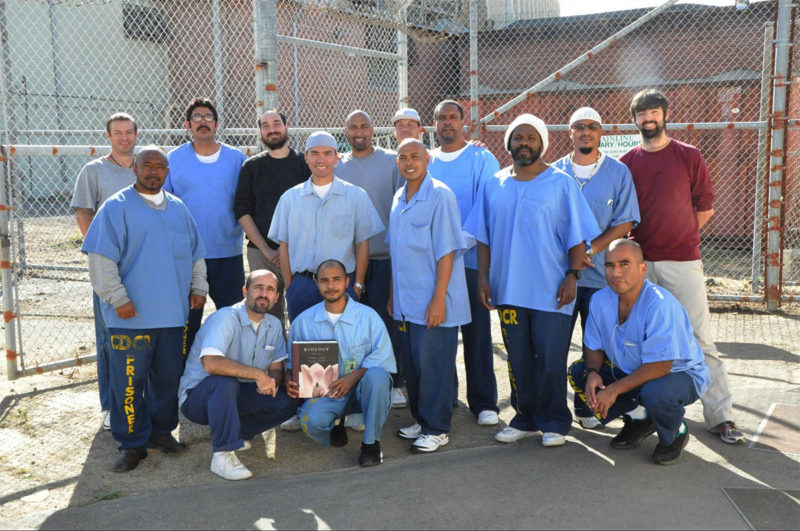
While higher education programs in prisons have been well-covered by various media outlets, the voices of students seeking out higher education while incarcerated are lacking. In this short iBiology film you can listen to the stories told by a unique group of passionate college students we consider ourselves lucky to work with.
They are part of the Prison University Project (P.U.P.), which supports a liberal arts college program inside San Quentin Prison, just north of San Francisco, California. San Quentin is an extension site of Patten University, and is one of only a handful of higher education opportunities currently available to incarcerated students in the state of California.
A typical class day…
Our course meets three times per week over a fifteen week semester. There are no prison guards in the classroom and the environment is a lively one, with all students participating in discussions and labs. The film gives you a great sense of the classroom environment—diverse, energetic and active. Teaching with P.U.P. is a truly invigorating experience.
As an example of a typical class, we covered photosynthesis during one period this past spring. Photosynthesis is a great topic to highlight how biology connects to other disciplines like physics and chemistry. We started with a short in-class discussion of photosynthesis focusing on the history of experimental research and talking about real data. For instance, George Engelmann’s beautiful work on wavelength dependence from the late 1800s.
We spent the majority of the class period quantifying photosynthesis by monitoring leaf disks rising in an aqueous solution that contained a source of carbon dioxide. Leaves from different types of plants were used in the lab. At the end of the period we reconvened to assemble the class data and discuss our results. A central goal of the course, regardless of topic, is to integrate labs and discussion into a single class period. This format requires that students “buy in” and participate actively, support one another, and be willing to share their findings with the group.
Our class also contained elements typical of other college-level courses. Students had reading assignments and homework. In addition to a midterm and final exam, students researched and wrote a paper on a topic of their choosing. Though students within the prison lack internet access we were able to bring them materials relevant to their topics.
Not just about teaching biology
Biology is an exercise in discovery, not memorization. The lab component is central to communicate this crucial concept. Not to mention no one wants to hear either of us talk for two hours! Having taught the class as just a lecture and as a lab-based course over our years working with P.U.P. we can’t imagine teaching introductory biology or any introductory science class without a well developed lab component.

As highlighted in the film, the sea urchin fertilization and early development lab is particularly memorable. Students have a chance to image living cells by microscopy, watch fertilization in real-time, and follow the early development of the urchin. This year (Spring 2016) all groups got urchins that developed to the Pluteus larval stage, which was truly humbling to observe when one had simply mixed sperm and egg just days prior. This year’s class collaborated on a methods paper that will serve as a lab manual for future classes. We titled our paper “Brutus, the Pluteus.”
The course material differs from year to year depending on the interests of the faculty instructors. This year we spent quite a bit of time on hippocampal neurogenesis, the birth of new neurons. We had the opportunity to quantify neurogenesis from exercised and sedentary animals and compare our results with data from Princeton undergraduates who did the same lab. Not only we were able to complete and interpret a set of measurements, we were able to compare our findings to data obtained by a group doing similar work across the country.
What happens next in the academic lives of the students?
Our class was not just a “one off”— biology with lab is offered approximately every other year by P.U.P. and exists within the constellation of other offerings. Most of our biology students are currently taking other P.U.P. courses towards their Associates of the Arts (A.A.) degrees including creative writing, philosophy, ethics, many math courses, and other science classes including physics, chemistry, neuroscience, and geology. In particular, many of our biology alumni are interested in learning more about public health, the human brain, and biotechnology.
A team effort
Our deepest thanks go to our past and present students and co-instructors for their willingness to try new things; P.U.P. team members for their hard work helping us clear lab materials; correctional staff for inspecting and approving said materials; and the UCSF Science Education Partnership (S.E.P.) for loaning us the vast majority of lab material used during the semester. Additionally, we thank The American Society for Cell Biology (A.S.C.B.) for a grant to purchase one of the microscopes used in class and a donation by Celestron for additional student microscopes.
We are happy to answer any questions you might have about the course. Send us an email: Ryan (mcgorty@gmail.com) and Adam (adampwilliamson@gmail.com). More information on the Prison University Project and how you can get involved can be found on the program’s website: http://www.prisonuniversityproject.org/
Adam Williamson is a postdoctoral fellow in the Cellular and Molecular Pharmacology department at UCSF. Ryan McGorty is an assistant professor in the Physics and Biophysics Department at the University of San Diego and taught this course while he was a postdoctoral fellow at the University of California, San Francisco (UCSF).





Leave a Reply